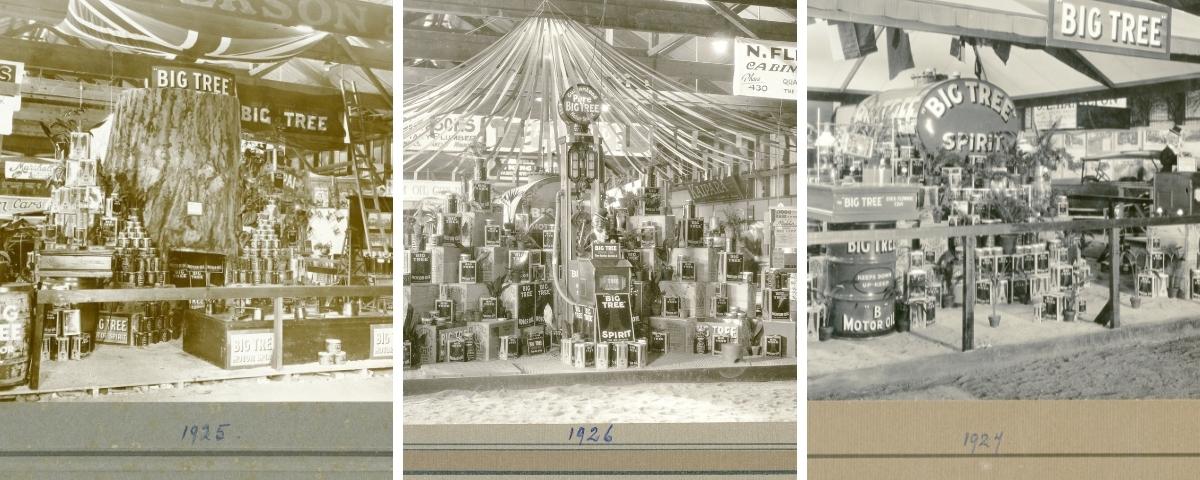Georgia Kerby, Exhibitions Curator
New Zealanders now, as in the past, buy their petrol from a mix of national and international providers. The predecessors of American company Mobil sold kerosene here in the 1870s and oils for carriages from 1896, growing into one of the earliest motor oil producers in New Zealand at the turn of the Twentieth Century. American Caltex and British BP and Shell are the other major fuel companies that we are familiar with.
While oil and gas deposits were explored in New Plymouth from a very early date of 1865, it took until 1913 for us to produce locally refined barrels of oil. Taranaki oil continued to make a small supply of ‘Peak Petrol’ into the 1950s, but the industry could not sustain itself.
Petrol companies worldwide achieved rapid growth during and following World War One, due to increased demand, ever rising use of motor vehicles, and improvements in drilling and refining technologies.
The comparatively slow growth of the New Zealand run oil and gas industry meant that kiwis relied on several American and British companies who sourced their oil mostly from the Middle East, including U.S. brand Big Tree.
Last year Mr. I. Mison donated a collection of historic photographs to Whangārei Museum, including those discussed in last week’s article. A selection of these photographs record the activities of Big Tree motor oil agents in Whangārei during the 1920s. Little can be found in regards to the origins of this petrol brand, but Big Tree appears in our newspapers from 1916 and quickly gained popularity due to its performance in motor races. Around this time, A. S. Paterson & Co. Ltd. became the main New Zealand agents of the branded oil with distribution branches around the country. A. S. Paterson & Co. were merchants of mostly farm supplies including manure, seeds, and stock meal, but also paints, and were based out of Auckland. An early promotional scheme was a tourist map of New Zealand, no doubt advertising their Big Tree benzine to help people on their tours. Competition in the 1920s included small fuel brands Plume, Kaliff, Lydol, Atlantic, Royal Crown and Howdah.
Whangārei’s Big Tree depot was on Walton Street, run by Captain W. R. Patterson and R. A. Stevenson. W. R. or ‘Skipper’ Patterson owned a warehouse on Walton Street from which he ran a launch hire business, which later made an ideal warehouse for distributing Big Tree products from. The first three photographs are from local photographer T. G. Palmer and record Big Tree trade stands at successive Winter Shows, 1925-1927. While attendance to the 1925 Whangārei Winter show was reported as “not very great”, the displays were visually excellent. A visitor could have listened to a concert by the Whangārei Municipal Band, watched a baby show and wandered among stalls advertising milking machines, cars, cabinetry and other local shops.
The Big Tree stalls each feature a central display surrounded by stacks of their various products. Their 1925 display features a large faux tree trunk, the icon of their brand, which is visible on early tin signs and wooden crates by the company. Their displays of the next two years recycled some of the same elements, including a large cylindrical tank, straight off the back of a truck.
Making up the main product of these stalls are four-gallon tins of petrol or ‘benzine’, as it was known, which were available for people to buy from general stores and garages until the development of pump stations or ‘bowsers’ in 1926.
In Big Tree’s trade show display of that year, a very early petrol pump can be seen center stage. Petrol pumps became more common around the country in the 1930s and 1940s. Kerosene and other oils were still being used to light homes and lubricate machinery as advertised by the Big Tree truck, photographed in a 1922 parade along Walton Street, discussed in last week’s article. However, the biggest market was the transport industry. During this time limits on the maximum and minimum prices of petrol were introduced.
Whangarei’s Big Tree representatives utilized any marketing opportunity and dressed their branded trucks up for at least two street parades in the 1920s. Pictured here are their trucks; the first includes Bill Richardson and on the left-hand side Skipper Paterson; in the second photograph, the truck is dressed in ribbons and topped with iconic tin cut outs of Big Tree policemen, which have become a rare find in the transport collectable trade. The man in the hat is identified as Walter Newman. These photographs highlight a little known, but clearly prolific, local branch of a once international business which has faded away, obscured by big multinational corporations. If anyone has any more information to light on Big Tree petroleum and the people yet unidentified in these photographs Kiwi North would love to hear from you.
